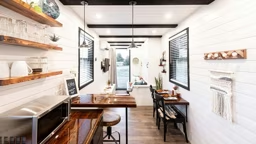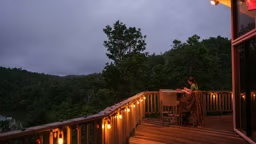
Building your own cabin instead of buying an existing one opens many design opportunities. However, the greater the customization, the greater the prices. If you want to build a cabin from scratch, you need to know the most cost-effective options and the various expenses that come with them.
Main Types of Cabins
There are dozens of unique cabin design concepts, but they all fall under a handful of main categories. Regardless of your personal customization ideas, your idea must have a structure that builders are familiar with. Go through the pros and cons of the main types of cabins.
Timber Frame Cabin
A timber frame is the first architectural style that comes to most people’s minds when they think of cabins. This design consists almost entirely of large wooden square-cut posts and beams joined together with pegs. The wooden frame and walls are left fully exposed, which gives the cabin a rustic visual appeal. Timber frame cabins have many advantages:
- The sturdy frame doesn’t need load-bearing walls and has basic maintenance requirements. You also don’t need to worry about foundation-settling issues.
- It’s an eco-friendly option, using almost 100% natural building materials and saving an average of four tons of CO2 emissions during its lifetime.
- Timber frame homes have flexible truss styles, including hammerbeam, scissor, queen post and king post. The floor plans are also highly customizable.
- Construction of timber frames is straightforward. Contractors will have little issue installing the frames, wiring and plumbing.
There is just one notable downside to timber frame cabins — rotting. Since they’re almost entirely made of wood, they are susceptible to decay over time. You must stain the exterior with a protective finish every three to seven years to protect the cabin from wood-eating pests, UV rays and harsh weather conditions.
Full Scribe Log Cabin
A full scribe cabin is a traditional design with Scandinavian roots going back thousands of years. Logs are grooved by hand and stacked horizontally to create the trademark log cabin appearance. This ancient architectural style tends to be expensive because of the tedious labor of grooving the logs, but it still has several advantages:
- They’re extremely durable and offer unmatched protection against the elements.
- Construction is quick and simple once the logs are grooved to your specifications.
- There is no need for drywall, siding or extra insulation.
Your main responsibility is choosing the right wood species for your full scribe cabin. The most popular choice is high-strength Douglas fir in the U.S. and Canada. Pines, cedars and spruces are also viable options.
Chink Log Cabin
Chink cabins are also known for their horizontally stacked logs, but they have one distinct feature — chinking. Chinking is an acrylic elastic substance that fills the gaps between the logs, much like mortar for bricks. This simple addition makes the cabins extremely effective insulators. Climate control will not be an issue with this style.
These cabins are great options if you’re interested in a self-sufficient lifestyle. Once the structure is complete, you simply have to keep the chinking intact. As long as you maintain the chinking’s bonding and sealing properties, the cabin will last you a lifetime.
Hybrid Cabin
Hybrid cabins combine multiple construction methods, such as timber frames and building materials like stone, glass, reclaimed siding and shake shingles. These structures have many custom design opportunities because of the variety of materials. However, you must keep in mind that more customizations lead to more expenses.
Hybrid cabins also have more maintenance requirements due to their complex designs. That’s why they’re almost always used as primary residences instead of vacation homes. You need to be around the property often to ensure consistent upkeep.
A-Frame Cabin
The A-frame cabin is the go-to style for DIY projects or people interested in off-grid living. As the name suggests, the main structure is a simple A-frame that uses minimal materials and supports its own weight. The steep pitched roof can also handle lots of snowfall, which makes it popular in colder climates.
The only big disadvantage of A-frame cabins is the sloping walls sometimes make interior design difficult. However, the open floor concept somewhat compensates for the walls and allows you to make more furniture rearrangements.
Prefab and Modular Cabin Kits
If building an entire cabin from scratch is out of your budget, you can also get a low budget prefabricated or modular cabin kit. For most prefab and modular projects, about 80%–90% of the construction takes place inside a factory or warehouse. This arrangement allows for safer work conditions and easier customization.
While building a cabin the traditional way will take seven and a half months on average, you can complete a prefab and modular cabin in half the time. These are the three main types of cabin kits you’ll encounter.
Shell-Only Cabin Kit
Shell-only cabin kits strictly consist of a cabin’s outside shell, including the roof, walls, doors, windows and uncovered floors. This kit is the most flexible option because you can customize every interior detail to your liking. It won’t surprise you to learn that rustic outdoor-themed styles are among the most popular interior types of shell cabin kits.
Dry-In Cabin Kit
Dry-in cabin kits are similar to shell-only kits but often have a few additional features. You can add decks, porches and other extensions to the exterior. You can also pay extra to install utilities and interior finishings such as drywall. Each additional feature increases the upfront cost, but dry-in cabins are still more affordable than the next option.
Turnkey Cabin Kit
The turnkey kit — also known as the complete package — includes everything you need for your cabin. It has the interior and exterior necessities of shell and dry-in cabin kits, plus the furniture, appliances and even decorations. Everything is built in and ready to accommodate the new owners once the builder turns the keys over.
Build the Cabin of Your Dreams
Whether you choose a traditional design or a prefabricated cabin kit, you have many ways of building the cabin of your dreams. Consider your budget, location and long-term plans before making a decision. Constructing a new home might be simple, but it won’t be easy. Carefully consider every option before deciding on your cabin’s style.










